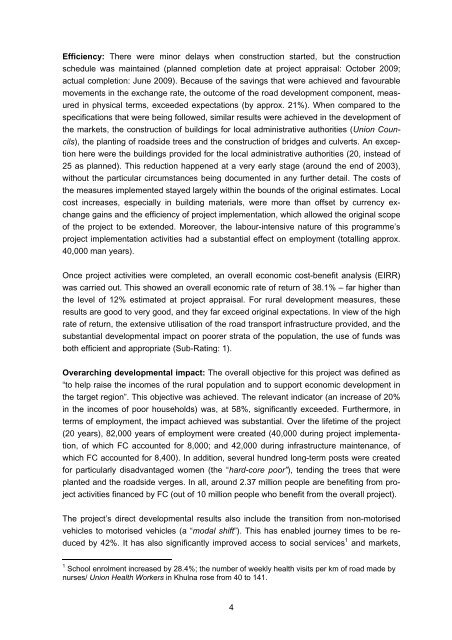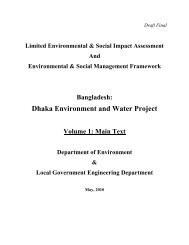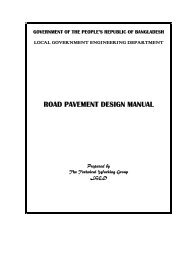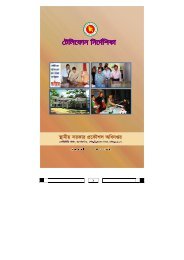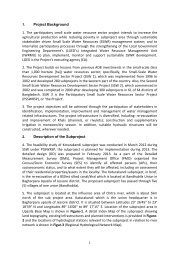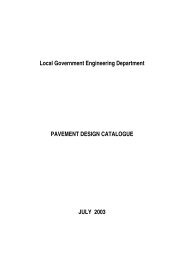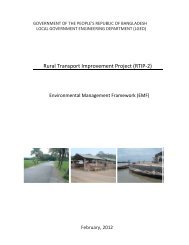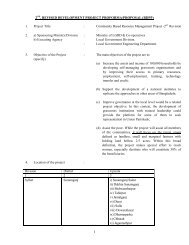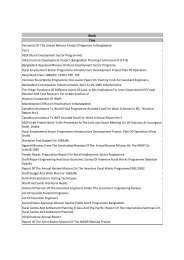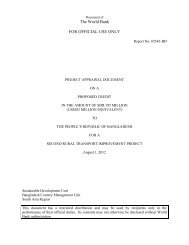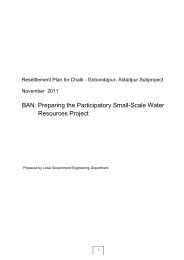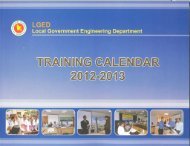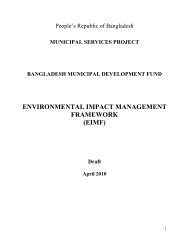Rural Markets and Roads, Khulna Division - LGED
Rural Markets and Roads, Khulna Division - LGED
Rural Markets and Roads, Khulna Division - LGED
You also want an ePaper? Increase the reach of your titles
YUMPU automatically turns print PDFs into web optimized ePapers that Google loves.
Efficiency: There were minor delays when construction started, but the construction<br />
schedule was maintained (planned completion date at project appraisal: October 2009;<br />
actual completion: June 2009). Because of the savings that were achieved <strong>and</strong> favourable<br />
movements in the exchange rate, the outcome of the road development component, measured<br />
in physical terms, exceeded expectations (by approx. 21%). When compared to the<br />
specifications that were being followed, similar results were achieved in the development of<br />
the markets, the construction of buildings for local administrative authorities (Union Councils),<br />
the planting of roadside trees <strong>and</strong> the construction of bridges <strong>and</strong> culverts. An exception<br />
here were the buildings provided for the local administrative authorities (20, instead of<br />
25 as planned). This reduction happened at a very early stage (around the end of 2003),<br />
without the particular circumstances being documented in any further detail. The costs of<br />
the measures implemented stayed largely within the bounds of the original estimates. Local<br />
cost increases, especially in building materials, were more than offset by currency exchange<br />
gains <strong>and</strong> the efficiency of project implementation, which allowed the original scope<br />
of the project to be extended. Moreover, the labour-intensive nature of this programme’s<br />
project implementation activities had a substantial effect on employment (totalling approx.<br />
40,000 man years).<br />
Once project activities were completed, an overall economic cost-benefit analysis (EIRR)<br />
was carried out. This showed an overall economic rate of return of 38.1% – far higher than<br />
the level of 12% estimated at project appraisal. For rural development measures, these<br />
results are good to very good, <strong>and</strong> they far exceed original expectations. In view of the high<br />
rate of return, the extensive utilisation of the road transport infrastructure provided, <strong>and</strong> the<br />
substantial developmental impact on poorer strata of the population, the use of funds was<br />
both efficient <strong>and</strong> appropriate (Sub-Rating: 1).<br />
Overarching developmental impact: The overall objective for this project was defined as<br />
“to help raise the incomes of the rural population <strong>and</strong> to support economic development in<br />
the target region”. This objective was achieved. The relevant indicator (an increase of 20%<br />
in the incomes of poor households) was, at 58%, significantly exceeded. Furthermore, in<br />
terms of employment, the impact achieved was substantial. Over the lifetime of the project<br />
(20 years), 82,000 years of employment were created (40,000 during project implementation,<br />
of which FC accounted for 8,000; <strong>and</strong> 42,000 during infrastructure maintenance, of<br />
which FC accounted for 8,400). In addition, several hundred long-term posts were created<br />
for particularly disadvantaged women (the “hard-core poor”), tending the trees that were<br />
planted <strong>and</strong> the roadside verges. In all, around 2.37 million people are benefiting from project<br />
activities financed by FC (out of 10 million people who benefit from the overall project).<br />
The project’s direct developmental results also include the transition from non-motorised<br />
vehicles to motorised vehicles (a “modal shift”). This has enabled journey times to be reduced<br />
by 42%. It has also significantly improved access to social services 1 <strong>and</strong> markets,<br />
1 School enrolment increased by 28.4%; the number of weekly health visits per km of road made by<br />
nurses/ Union Health Workers in <strong>Khulna</strong> rose from 40 to 141.<br />
4


